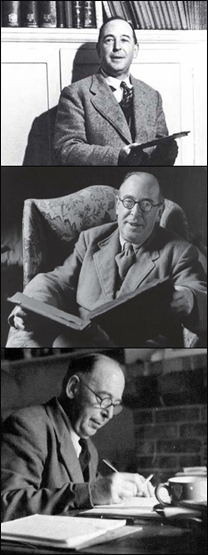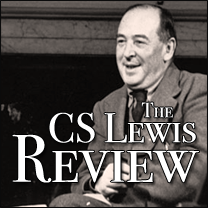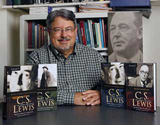
Thinking Christianly Re: Auto/biography
July 5th, 2008 | Skip to comments
Copyright 2008 by Bruce L. Edwards. (Click here for Permissions information)
The genres of biography and autobiography refer, literally, to writing (“graphing”) a life (“bio”), one’s own or someone else’s. In the West, they are regarded as fact-driven works created to capture and preserve the life—and usually the times—of notable individuals.
Biographies are presumed to be the product of research, the submersion of their authors in the milieu of their subjects, built upon the canvassing and collating of events, interviews, conversations, diaries, letters, and other related historical documents, accounts, and artifacts contemporary with their period.
Such primary research is often refined as well by reflection upon the subject outside of her or his own historical context, that is, in view of the subject’s reputation earned, corrected, or abandoned by other fellow biographers.
The motives of biographers may vary; one may wish simply to try to assemble the facts of a human life in chronological order: what, where, who, when, how, and why—but minimizing “interpretation”; another may choose to explain and thus focus a historical period through the lens of a single life deemed as significant and “telling” beyond its immediate context and period; still others may choose to assess the value and impact of an individual simply in order to praise or condemn the person’s contributions to history.
There also exist the modern phenomena of the “authorized biography” and the “pseudobiography.” The former presumes the cooperation of the subject or the subject’s estate and/or family and the guarantee of access—if not right of editorial approval—to documents and artifacts that otherwise would be off-limits to the general public. The latter comprises a quasi-biographical text, only for a fictional subject that may mirror the complete life of an actual subject, e.g., Dickens’ David Copperfield.
Autobiographers, those who choose to set forth their lives in their own words, with or without the help of researchers, editors, or “ghost-writers,” intend to create an account of what they have seen, heard, and done with their own eyes, ears, and hands. Their works offer pre-emptive, personal, candid interpretation and/or declaration of how and why they have behaved the way they have.
Their goal is providing a self-made soliloquy of what is remembered: who or what has importance to them, and how they wish the meaning of their lives to be construed by posterity, sometimes to counter their presumed detractors during the era in which they lived.
According to biographer Kenneth Silverman one may distinguish “history” from “biography” by understanding that “History concerns what Napoleon did; biography concerns what it meant to him.” Historians and historiographers disagree, however, about whether there can ever be (or whether it is even preferable to have) a “neutral” or “objective” stance in rendering a life in a biography; to write is to interpret, to have a stance.
Most choose their subjects for a reason, often their admiration, sometimes their disgust, and that reason will guide their selection and arrangement of “facts” and their final contextualization. But wantonly fictionalized or highly inaccurate or stupendously embellished biography or autobiography would seem to be contradictory to the whole endeavor and inimical to the reader seeking a tolerably accurate, compelling account of a life.
The reputable biographer, nevertheless, willingly labels speculation as such, and tries not to present reconstructions, inventions, supposals as “what really happened.” Documentation is the hallmark of the biographical enterprise; how is the narrative corroborated? An armchair autobiographer may be charming, but a biographer who never leaves the room is problematic, perhaps a contradiction or a fraud.
No biography or autobiography can be exhaustive, of course; even John the Apostle admonishes: “Jesus did many other things as well. If every one of them were written down, I suppose that even the whole world would not have room for the books that would be written” (John 21:25; NIV).
And none can claim infallibly to “tell the truth” of a life if by that one means to insure that every datum cited in a volume is verifiable beyond doubt and depicted without prejudice of any sort; we are human, flawed, and finite, and on some things we simply must surmise, guess, conclude, leaving the judgment to the reader.
It is difficult to determine the origins of biography and autobiography in human discourse, but one can conclude that the genre is as old as human language itself, and appears in all civilizations that developed a writing system. Writing has multiple purposes everywhere it is found—charting genealogies, recording business transactions, regulating social mores, preserving all manner of culture, myth, and story in prose and poetry—but more often than not it is used to connect one generation to the next by setting down the life stories of leaders, heroes, kings, queens, villains, and knaves who help explain how we got to one point or another in history.
Early on it is, in fact, difficult to distinguish what is intended as “biography” from mere “sponsored myth”; in antiquity, court scribes in Assyria, Babylonia, or Egypt, are likely to have been commissioned to detail the wondrous exploits, triumphs, wisdom of their illustrious rulers, weaving them into a mix of history and legend.
The earliest traces of what might be called modern biography emerge in the ancient Greco-Roman world from the impulse to de-link members of a community from a larger mythopoeic narrative to a more local, self-consciously politicized context, depicting less the lives of the gods, than the lives of those the gods have chosen. These more or less “fact-based” texts seek to identify and explain the significance of human individuals who bear traits worthy to be emulated, commemorated, and celebrated, or, by contrast, to be deplored, ridiculed, and shunned.
Isocrates (ca. 390-338, B.C.) wrote of Evagoras, and may classify as the earliest real attempt at “bio-graphing,” though that term does not become common until the 5th Century, A.D. Meanwhile, Herodotus (480-425 B.C.), Thucydides (460-? B.C.), and Plutarch (45-125 A.D.), all more historians than biographers, do help extend the biography as vignette in the midst of historical narrative—as did Plato in his skillful and engaging dialogues, recounting of the teaching and philosophy of his mentor, Socrates (427-347 B.C.). Suetonius (65?-130?), author of The Lives of the Noble Caesars, continues the tradition forward in his era, as does the work of Jewish historian, Josephus (37-95 A.D.)
In the roughly parallel developments that occur during the production of Biblical literature, biography as such is even more essential to the Bible’s core message and themes, starting with the Book of Genesis, in which God Himself as a personal-infinite-creative being is introduced. But the Bible does not contain, strictly speaking, the biography of God, who is outside of time and history—but rather of His creation. Thus biographical vignettes of Adam, Eve, Cain, Abel, Noah and his clan, and on through Abraham, Isaac, and Jacob form the threads of Hebrew—and Christian—history in this initial volume.
Indeed, the Books of Moses are nothing if not auto-/biographical summaries of key events, personages, encounters, lessons learned and destinies earned and spurned. The remainder of the Hebrew Scriptures are filled with the individual accounts of lives lived under or in rebellion to the Law of Moses, and the consequences thereof, as found in the wisdom and prophetic literature. From the Christian perspective, these sacred texts also comprise the proto-biography of the coming Messiah, revealed and depicted in the New Testament as Jesus Christ.
It has often been said that the Gospels are a unique genre unto themselves in the ancient world, differing even from the Greek and Roman historians in their character and substance. Literary scholar and Christian apologist, C. S. Lewis, has suggested that in some sense the writers of the Gospels help “invent” the eyewitness account, rendering as they do the life of Christ with a sense of immediacy yet chronology that suggests a prudent awareness that others might be “fact-checking,” and thus it was important to get it right.
Luke, responsible for not only a Gospel but for the early history of the church in the Book of Acts, explicitly states his modus operandi for authorship: “Many have undertaken to draw up an account of the things that have been fulfilled among us, just as they were handed down to us by those who from the first were eyewitnesses and servants of the word. Therefore, since I myself have carefully investigated everything from the beginning, it seemed good also to me to write an orderly account for you, most excellent Theophilus, so that you may know the certainty of the things you have been taught.” (Luke 1:1-4; NIV); and, later: “In my former book, Theophilus, I wrote about all that Jesus began to do and to teach until the day he was taken up to heaven, after giving instructions through the Holy Spirit to the apostles he had chosen.” (Acts 1:1-2; NIV).
The Gospels are, in fact, four distinct biographies of Jesus, the deliberate and purposeful recording of his words and deeds, and with the express purpose of identifying him as the Messiah of Israel, the Savior of the World, the only begotten Son, the incarnate God. Chronology is important to them, but is not the only organizing principle at work.
The thematic coherence of fulfilled prophecy and the arresting, incomparably distinctive effect of Jesus’s teaching and miracles on common folk, as well as the religious elite, the occupying politicians, and the illiberal intelligentsia, are also important as narrative strategies for distilling His character—and rendering His personality. Matthew, Mark, Luke, and John become the exemplars of the biographical form for later Christian writers to the present.
If, in the secular West, “biographies” are based on the “great man” theory of history, perhaps it could be said that subsequent Christian biography and autobiography are based on the “great sinner” theory of history. The earliest Christian works of this sort are confessional and their avowed purpose is to detail the pre- and post-conversion life of the wayward, and the redeemed path that the penitent has been enabled to walk because of God’s mercy. Notable here is Augustine’s Confessions, a 4th-Century work that recounts the Bishop of Hippo’s tortured life before turning to Christ (“our hearts find no peace until they rest in You”).
In A.D. 380, Gregory, Bishop of Nyssa (335?-395?), penned a biography of his beloved sister and greatest spiritual influence, Macrina, upon her death, foregrounding within the text her insistence that the motive for reflecting on one’s life at all is to offer continual “thanksgiving to God,” which perhaps becomes the model for all Christian auto-/biography throughout the next 10 centuries.
Such works are designed to elevate Christ and serve as sturdy companions both to the Biblical witness and devotional reflection on one’s own life. As testimonies, they may also serve evangelistically, encouraging the reader or hearer to take a similar path toward the light.
As we move from the end of the Greco-Roman period of Christianity, and the church grows and expands beyond its original borders, more biographical and autobiographical texts appear, often what we now call “hagiographical,” meaning: written to establish the case for sainthood, the depiction of an exemplary life that can inspire others to seek the same.
(The term “hagiographical,” when applied to contemporary biographies, can also be a pejorative term, indicating a lack of objectivity or distance from the subject, and a tendency to write in hyperbole, creating an unwarranted, exalted view of the life under consideration.)
The lives of saints, martyrs, church leaders of all sorts appear to encourage those who could read (or be read to) to follow in their steps. The 15th-century Booke of Margery Kempe is usually considered the first post-middle ages autobiography, a unique work by a female author that details Kempe’s journey to the Holy Land, though it was virtually unknown when first published in 1936.
But as one moves further into the Middle Ages, biography and autobiography escape ecclesiastical motives nd settings into a period more deliberately humanist in outlook, signaled in the rise once more of “secular heroes,” as Thomas Malory’s Morte d’Arthur (1485) and Giorgio Vasari’s Lives of the Artists (1550) represent.
Such works co-exist later with familiar devotional works like Foxes Book of Martyrs (1563) and John Bunyan’s Grace Abounding to the Chief of Sinners (1666), which offers a pious autobiography combining Augustine’s confessional mode with Thomas a Kempis’ directive counsel.
The coming of age of modern biography is exemplified in the 18th Century by Jean-Jacques Rousseau’s revolutionary, highly secularized Confessions (1781-88); James Boswell’s Life of Johnson (1791), a jaunty, blog-like tribute to personal friend, polymath, and dictionary-maker, Samuel Johnson; and American Benjamin Franklin’s witty, tour de force Autobiography (first published in 1791, in French; then in 1793, in English).
These works become a touchstone for the expectations raised for later biographers, especially for their compulsively disclosive, “insider” reference point, creating the sense of “eavesdropping” on a personable, engaging historical subject willing to “tell all.”
It might be said that Christian biography also comes into its own in the 19th-Century in the English-speaking world, dominated by life stories inspired by the mission field. The personal accounts as well as the compiled and quite episodic memoirs of such missionary stalwarts as William Carey (1761-1834), Hudson Taylor (1832-1905), and David Livingstone (1813-1873), become pervasive models for edification and imitation, especially among protestant Christian readers.
Entering the 20th-Century, one finds more reflective, full-scale biographies, as public and Christian appetites for “lives well told” expand, and the new American Century explains itself religiously as well as politically. In the early 20th Century, the “great sinner,” reflexive mode of biography (demonstrated par excellence in the saga of evangelist Billy Sunday) begins to give way to the more critical, interrogative, start-to-finish narrative we now associate with both religious and secular biography.
Readers’ expectations for authenticity and realism overcome their desire for mere drama and inspiration, while hoping both the latter emerge naturally from the life depicted without contrivance. Taste evolves so that subjects need not be the “worst of sinners” or the “best of saints” to render compelling reading; the extraordinary and the ordinary should intermix, and neither should artificially constrain the other.
C. S. Lewis’s 1956 spiritual autobiography, Surprised by Joy, stands out as just such a volume, candor mixed with self-effacement by one widely-regarded as the premier Christian apologist of the twentieth century. Lewis proceeds in Surprised by Joy as one reluctant to reveal specific details of his life but who relents, as he suggests in the preface, in order both to answer “requests that I would tell how I passed from Atheism to Christianity” and “to correct one or two false notions that seem to have got about.”
Lewis’s reluctance involves not just conventional modesty wishing to downplay the importance of his life, but stems just as much from his conviction that no writer’s work is especially illuminated by psychological inquiry into his or her life. As a renowned literary critic and literary historian himself, he had witnessed too many works passed off as “literary criticism” that were instead imagined reconstructions of the author’s composing process or thought life—poor substitutes for thoughtful attention to an author’s text itself.
Lewis referred to this twentieth-century critical preoccupation as “the personal heresy”: the tendency to identify authors with their creations, assuming that each work is somehow and essentially a rehearsal of a writer’s own life. Lewis believed this artistic heresy robbed works of their power and meaning by reducing all literary criticism to biographical skullduggery. He thus rejected out of hand the notion that anyone famous or otherwise was obligated to lay bare the private life—either for the sake of celebrity or for its putative insights into his or her literary works.
Thus, to accomplish the task he set for himself, Lewis was forced to overcome his “distaste for all that is public, all that belongs to the collective.” Nothing is included that is not directly related to this purpose. Lewis charmingly and ironically warns the reader in his preface:
The story is, I fear, suffocatingly subjective; the kind of thing I have never before and shall probably never write again. I have tried so to write the first chapter that those who can’t bear such a story will see at once what they are in for and close the book with the least waste of time.
The subtitle of the book, “the Shape of my Early Life,” succinctly captures the scope of Lewis’s autobiography; it is chiefly his pre-conversion intellectual journey that Lewis believes needs charting, and his is not a grand repentance from fleshly indulgence but a recovery of a child-like wonderment at the world and its mysteries. Never one to be accused of personalized hyperbole, Lewis’s grand climax to his journey of faith is announced in matter-of-fact, demure terms:
Every step I had taken, from the Absolute to “Spirit” and from “Spirit” to “God,” had been a step toward the more concrete, the more imminent. . . . To accept the Incarnation was a further step in the same direction.
The Future of Biography
The next generation of biographers and autobiographers will have the simultaneous advantage and dilemma of stalking multimedia sources of data with which to depict a life.
The pervasiveness of internet-based storage of images, audio, and video, and the seemingly endless cascading of words and more words from individuals from cradle to grave presents a daunting challenge to those who would “capture a life” with proportion, scale, wit, and modesty.
Among Christian readers and writers, perhaps, the task is somewhat mitigated by the recognition that ultimately God is the Great Biographer, the Author and Finisher of Faith, and will have the final Word on all lives.
Selected Bibliography




Comments
No comments yet.
RSS feed for comments on this post.
Sorry, the comment form is closed at this time.